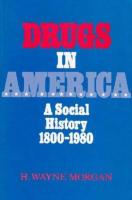Description
Only in the last hundred years have the realities of drug use in America--particularly of opiates, chloral hydrate, cannabis, cocaine, and the chemical drugs of the twentieth century--run counter to a growing country's image of itself as rational. efficient, and independent.
In the early and mid-nineteenth century the image of the prescribing physician as a reliable figure of authority and knowledge, and the widespread use and sanction of opium, "God's own medicine," masked the dangers of addiction and drug abuse. But spreading addiction, especially among women, infants, and physicians themselves; visible, debilitating effects on users; and racial stereotyping-- the Chinese
with opium, and later blacks with cocaine, and Mexicans with marihuana--challenged late nineteenth-century America's vision of a healthy and productive society.
Drawing upon a wealth of untapped primary resources, Morgan traces changes in the popular attitude toward drug use over the past two centuries; the rise of legal restrictions; the prolific "cure" business; the idea of drug use as enslaving, unamerican, and unpatriotic; and from the 1920s to the 1950s the linking of drugs with a new spirit of social rebellion.
Product Details
- Syracuse University Press Brand
- Aug 1, 1982 Pub Date:
- 0815622821 ISBN-10:
- 9780815622826 ISBN-13:
- 248.0 pages Paperback
- English Language
- 9 in * 0.65 in * 6 in Dimensions:
- 1 lb Weight:




